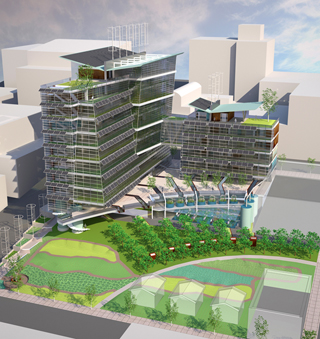|
Subscribe / Renew |
|
|
Contact Us |
|
| ► Subscribe to our Free Weekly Newsletter | |
| home | Welcome, sign in or click here to subscribe. | login |
Environment
| |
April 22, 2008
A green dream wins 2008 Cascadia design challenge
Journal Staff Reporter
The Cascadia Chapter of the U.S. Green Building Council chose the Eco-Laboratory project designed by four architects from Weber Thompson to win the 2008 Natural Talent Design Competition.
The competition invited students and people working in the field less than five years to submit designs for a “living building,” based on a program developed by Cascadia CEO Jason McLennan that aims to create self-sustaining buildings. The Emerging Green Builders program is a national initiative of the USGBC. Winners at the chapter level will compete for best national design at the annual GreenBuild conference.
The winning project, which is theoretical only and will not be built, was designed by Brian Geller, Myer Harrell, Chris Dukehart and Dan Albert for a site at the corner of Elliott Avenue and Vine Street in Belltown.
The site is now home to a 7,200-square-foot p-patch and three landmarked cottages. Their conceptual project would fill the block and involve people in the community, including people who are homeless.
The project would blend a neighborhood market, market-rate housing, basic shelter, vocational training and an educational center to teach people about sustainability.
The judges were California architect Sim Van der Ryn; Ben Gates of Central City Concern in Portland; Richard Iredale of Iredale Group Architecture in Vancouver, B.C.; Lance Jacubek of CMCH of Ontario; Thor Peterson of Cascadia; and David Posada, winner of last year's competition.
Judges said they liked how the project used existing resources.
“It really did take the three-legged stool concept and wove it together really rather seamlessly,” Peterson said. “It was honest, upfront and pragmatic about the concept of having market-rate housing that would actually subsidize some of the other more socially oriented aspects of the project.”
The building would mix long-term housing for people trying to reintegrate into society with market-rate housing. Meals, hygiene and shelter for the working poor and homeless would be provided on site, and there would be a training center to teach residents about urban agriculture.
Judges also liked how the team concentrated on so many aspects. Geller said that was the goal: “There's no real one feature that's the coolest. It's really just making them all work together and that was sort of our whole thrust.”
Here are some things the building would do:
• Collect water through impervious surfaces. A “living machine” would convert black water to gray and potable water. That water would supply water for residents, indoor vegetation and exterior landscaping.
• The building would harness solar, wind, biofuel and hydrogen fuel sources to generate power.
• Earth tubes would pull fresh air from the garden through indoor occupied spaces to increase indoor air quality.
• Concrete walls would use fiber-optic aggregate to reveal the systems within and allow light to permeate inner spaces.
• Demolition materials would be used in construction and for fill.
• The Eco-Laboratory would extend itself into the landscape and the landscape would extend into the building.
The designers said they would use reclaimed shipping containers as the main modules for living units but judges said using another module would be a better idea.
The project sounds fanciful but Geller thinks something similar could be constructed in the near future. “I don't think it's as far out as people would think because a lot of what we've done is probably going to be necessary to meet the 2030 Challenge and other initiatives,” he said. The 2030 Challenge states buildings should be carbon neutral by 2030.
Geller said he was approached by a number of community housing developers after winning the competition who were interested in the ideas.
Geller said Weber Thompson wanted to enter a regional design competition this year, and the Natural Talent Design Competition was the perfect opportunity. It took team members about five weeks of almost full time work to design the project.
Three other projects were entered in the competition. The Junction by the Victoria EGB won honorable mention. The other two entries were New Environmental Regional Design by students in Vancouver, B.C., and The Tower by Matt Eaton of Environmental Works in Seattle.
Katie Zemtseff can be
reached by email or by phone
at (206) 622-8272.



